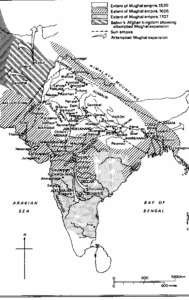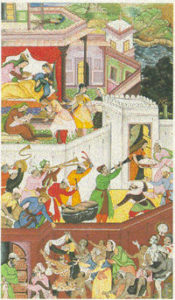Vinay Lal
The great grandson of Tamerlane, Babar, who on his mother’s side was descended from the famous Genghiz Khan, came to India in 1526 at the request of an Indian governor who sought Babar’s help in his fight against Ibrahim Lodi, the last head of the Delhi Sultanate. Babar defeated Lodi at Panipat, not far from Delhi, and so came to establish the Mughal Empire in India. Babar ruled until 1530, and was succeeded by his son Humayun, who gave the empire its first distinctive features. But it is Humayun’s son, Akbar the Great, who is conventionally described as the glory of the empire. Akbar reigned from 1556 to 1605, and extended his empire as far to the west as Afghanistan, and as far south as the Godavari river. Akbar, though a Muslim, is remembered as a tolerant ruler, and he even started a new faith, Din-i-Ilahi, which was an attempt to blend Islam with Hinduism, Christianity, Jainism, and other faiths. He won over the Hindus by naming them to important military and civil positions, by conferring honors upon them, and by marrying a Hindu princess.
Akbar was succeeded by his son Salim, who took the title of Jahangir. In his reign (1605-1627), Jahangir consolidated the gains made by his father. The courtly culture of the Mughals flourished under his rule; like his great grand-father, Babar, he had an interest in gardens, and Mughal painting probably reached its zenith in Jahangir’s time. Jahangir married Nur Jahan, “Light of the World”, in 1611. Shortly after his death in October 1627, his son, Shah Jahan, succeeded to the throne. He inherited a vast and rich empire; and at mid-century this was perhaps the greatest empire in the world, exhibiting a degree of centralized control rarely matched before. Shah Jahan left behind an extraordinarily rich architectural legacy, which includes the Taj Mahal and the old city of Delhi, Shahjahanabad. As he apparently lay dying in 1658, a war of succession broke out between his four sons. The two principal claimants to the throne were Dara Shikoh, who was championed by the those nobles and officers who were committed to the eclectic policies of previous rulers, and Aurangzeb, who was favored by powerful men more inclined to turn the Mughal Empire into an Islamic state subject to the laws of the Sharia. It is Aurangzeb who triumphed, and though the Mughal Empire saw yet further expansion in the early years of his long reign (1658-1707), by the later part of the seventeenth century the empire was beginning to disintegrate.
Aurangzeb remains a highly controversial figure, and no monarch has been more subjected to the communalist reading of Indian history. He is admired by Muslim historians for enforcing the law of the Sharia and for disavowing the policies pursued by Akbar; among Hindus, laymen and historians alike, he is remembered as a Muslim fanatic and bigot. In the event, Aurangzeb’s far-flung empire eventually eluded his grasp, and considerable disaffection appears to have been created among the peasantry. After Aurangzeb’s death in 1707, many of his vassals established themselves as sovereign rulers, and so began the period of what are called “successor states”. The Mughal Empire survived until 1857, but its rulers were, after 1803, pensioners of the East India Company. The last emperor, the senile Bahadur Shah Zafar, was put on trial for allegedly leading the rebels of the 1857 mutiny and for fomenting sedition. He was convicted and transported to Rangoon, to spend the remainder of his life on alien soil.

The Mughal Empire, 1526 to 1707 Source: F. Robinson, Atlas of the Islamic World since 1500 (Oxford, 19822), p.59.
Further Reading:
Habib, Irfan. The Agrarian System of Mughal India. London, 1963.
Habib, Irfan. An Atlas of the Mughal Empire. Delhi, 1982.
Qureshi, I. H. The Administration of the Mughal Empire. Karachi, 1966.
Richard, John F. The Mughal Empire. Vol. I, Part 5, of the New Cambridge History of India. Cambridge: Cambridge University Press, 1993.
Copyright, Vinay Lal 2001
A Greek translation of this article by Xristos Begopoulos can be found at: http://dailyanswers.net/the-mughal-empire-greek-translation/.
A Georgian translation of this article by Ana Mirilashvili can be found at: http://lpacode.com/the-mughal-empire/
A Bulgarian translation of this article by Will Gamble can be found at: http://bookieboost.com/4-the-mughal-empire-bg/
A Portuguese translation of this article by Artur Weber can be found at: https://www.homeyou.com/~edu/o-imperio-mughal.
A Finnish translation of this article by Elsa Jansson can be found at: http://mysciencefeel.com/2017/02/03/mughal-imperiumi/
This article has been translated into Romanian and be accessed at: http://webhostinggeeks.com/science/mughals-sscnet-ro
A Croatian translation of this article by Milica Novak can be found at: http://pro4education.com/the-mughal-empire
A Polish translation of this article can be found at: http://www.pkwteile.de/wissen/imperium-mogolow
A German translation of this article can be found at: http://www.gutscheindrache.com/wissen/das-mughal-reich/
An Indonesian translation of this article can be found at: http://www.chameleonjohn.com/translations/mughals-Indonesian
A Ukarainian translation of this article can be found at: http://eustudiesweb.com/the-mughal-empire/
A Russian translation of this article can be found at: http://www.enginearena.com/blog/mughal-empire/
An Albanian translation of this article by Vera Hoxha can be found at: https://gameresponse.com/perandoria-mughal/
A Bosnian translation of this article can be found at: http://the-sciences.com/2017/01/09/mughal-carstvo/
A Czech translation of this article by Philip Egger can be found at https://www.a-writer.org/translation/#The-Mughal-Empire:CZ
A Malay translation of this article by Clara Decker can be found at https://www.couponsmonk.com/blog/mughals-malay/
A Norwegian translation of this article by Arno Hazecamp can be found at http://www.ncsm.nl/study#The-Mughal-Empire:NO
A Russian translation of this article can be found at: http://edutranslator.com/imperija-velikih-mongolov/
A Punjabi translation of this article by Amaan Singh can be found at: https://www.bydiscountcodes.co.uk/translations/the-mughal-empire/
A Hungarian translation of this article by Patrick Kaufmann can be found at: https://write-my-essay-for-me.com/edu/#The-Mughal-Empire:HU
A Lithuanian translation by Lukas Šalna can be accessed here: https://www.eldorado.gg/translations/mogolu-imperija A Spanish translation of this article can be found at: https://chicksgold.com/blogs/the-mughal-empire


